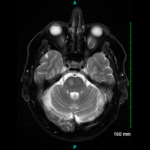Benefit of Methotrexate as Adjunctive Treatment for Giant Cell Arteritis Confirmed
A study in the August issue of Arthritis & Rheumatism (2007;56:2789-2797) looked at individual patient data from three placebo-controlled trials testing the effectiveness of methotrexate (MTX) as an adjunctive treatment for giant cell arteritis (GCA). This meta-analysis found that, when given in addition to standard corticosteroid treatment, MTX lowers both the risk of GCA relapse and the amount of corticosteroids needed.
Corticosteroids like prednisone are currently the primary option for treating GCA, a vascular disease characterized by inflammation of large arteries, usually in the head, that plagues fewer than 200,000 Americans. If left untreated, GCA can cause headaches, pain and stiffness, and even blindness.
Corticosteroids, given at first in high doses and then tapered down over several months, are “an extremely effective therapy” for GCA, says Peter A. Merkel, MD, MPH, director of the Boston University Vasculitis Center and lead author of the new study. “The critical problem is that they have significant toxicity, especially in the elderly,” he explains.
Indeed, for 53% to 86% of GCA patients, corticosteroids induce serious side effects like mood changes, weight gain, cataracts, and osteoporosis.
Several clinical trials have tested the use of low-dose MTX as an adjunctive treatment for patients with new-onset GCA. But the three largest randomized, placebo-controlled trials came to different conclusions: One showed a clear benefit of using MTX in reduction of GCA relapse and reduced use of corticosteroids; one showed mixed results; and one showed no clear benefit.
These discrepancies led to “great variation within the rheumatology practice community as to the use of MTX,” says Dr. Merkel. Because MTX has its own potential side effects, including liver toxicity, bone marrow toxicity, and GI upset, many doctors were cautious about prescribing it to their elderly patients. The meta-analysis of combined data from the three studies aimed to resolve these discrepancies.
At least one author from each of the three studies was involved in the new study, which pooled comprehensive data – including the time to first relapse, time to second relapse, cumulative dose of corticosteroids, time to discontinuation of corticosteroids, and adverse events – from 161 patients. Using the original data from individual patients, rather than that published in summary tables, “provided for much more sophisticated analyses and more precise estimates of outcomes,” says Dr. Merkel.
The analysis found that after 48 weeks of treatment, patients who received MTX and corticosteroids had a 63% chance of first relapse and 22% chance of second relapse. Patients receiving a placebo and corticosteroids had a significantly higher risk of both first and second relapse – 80% and 40%, respectively.
Moreover, MTX reduced patients’ need for corticosteroids. At 48 weeks, those treated with MTX had taken an average of 842 mg less of corticosteroids than those who were treated with placebo.
The researchers speculate that the initial discrepancies among the three studies arose because of differences in the length of follow-up. The benefit of MTX only appears after 24 to 36 weeks of treatment.
Though the study supports the use of MTX as adjunctive therapy in patients with new-onset GCA, Dr. Merkel emphasizes that corticosteroids must remain “the first and most important therapy. We don’t want a single doctor to think MTX should replace them.”
Psoriatic Arthritis Patients Without Classic Atherosclerosis Risk Factors Often Have Subclinical Disease
Psoriatic arthritis (PsA) patients have an increased risk of experiencing adverse cardiovascular events, according to a study published in Arthritis Care & Research (2007;57:1074-1080).
Several previous studies have asked whether patients with PsA – like patients with RA – have an increased risk of developing cardiovascular disease and thus have a higher mortality rate than the general population. But the results of these studies differed: some found a correlation and others did not.
To answer the question more definitively, a group of Spanish researchers used non-invasive ultrasonography to determine the intima-media thickness (IMT) of the carotid arteries and the presence of carotid plaques in 59 PsA patients and 59 matched control subjects. They found that PsA patients had significantly larger IMTs than matched controls. Though plaques were more often found in the PsA patients than the controls (nine and three patients, respectively), the difference was not statistically significant.
Because the IMT of the carotid arteries directly correlates with the risk of experiencing adverse cardiovascular events, the authors of the new study say these results show that PsA patients – even those without traditional risk factors – are at greater risk of cardiovascular disease.
The study confirms for the first time “that psoriatic arthritis by itself, regardless of other factors, is associated with accelerated atherosclerosis,” says lead author Miguel A. Gonzalez-Gay, MD, PhD, of the rheumatology department at the Hospital Xeral-Calde in Lugo, Spain. He was not especially surprised by these results, as they agreed with some epidemiological data reported by Canadian researchers.
Dr. Gonzalez-Gay recommends that, like RA patients, all PsA patients receive an ultrasound to determine IMT thickness. “The technique is cheap and rapid,” he says.
Moreover, he stresses that doctors should prescribe statins to PsA patients in order to keep their LDL-cholesterol levels low. As with patients who have diabetes or coronary artery disease, he says, PsA patients should ideally maintain LDL-cholesterol levels of about 100 mg/dl, which is lower than the 140-160 mg/dl that is normal in patients who are not at risk.
Virginia Hughes is a medical journalist based in New York City.

